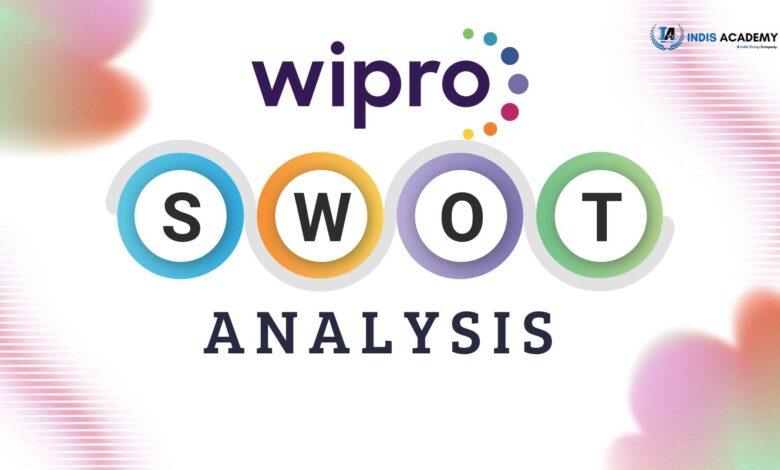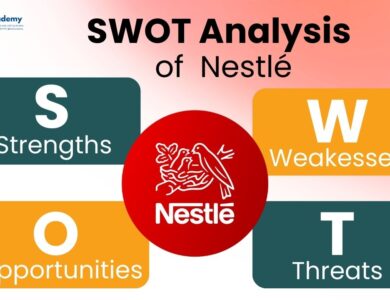SWOT Analysis of Wipro: Strengths, Weaknesses, Opportunities & Threats
Learn how Wipro positions itself in the IT industry with this SWOT analysis covering internal capabilities and market-driven threats.

Wipro isn’t just one of India’s oldest companies—it’s a name that helped put India on the global IT map.
Founded in 1945, Wipro started as a vegetable oil company. Today, it’s a $11+ billion multinational tech corporation serving clients in over 60 countries. Whether it’s cloud services, AI, cybersecurity, or consulting—Wipro has its hands in almost every tech domain.
But in a market dominated by giants like TCS, Infosys, HCL Tech, and international players like Accenture, is Wipro keeping up?
To find out, let’s dig deep into Wipro’s SWOT Analysis—exploring what drives its success, where it struggles, what opportunities lie ahead, and what external threats it must watch out for.
Also Read: Complete SWOT Analysis of Bajaj – From Two-Wheelers to Global Exports
Learn AI & Digital Marketing,
Pay Fees After Placement
- ✅ Minimal Admission Fees
- ✅ No Loan or Income Sharing Agreement
- ✅ 100% Placement Support
- ✅ ISO & Govt Registered Certificate
- ✅ Practical 3+1 Months Duration
Get a free counseling call. We’ll guide you through learning, certification, and job placement.
Request a Free Call Back
Takes less than a minute.
Strengths of Wipro
Wipro has several competitive advantages that make it stand tall in the IT services industry. Here’s what makes it strong:
✅ 1. Global Presence with Trusted Brand
Wipro has a strong global presence with delivery centers and partnerships in 60+ countries. Clients trust the brand for its process quality, compliance, and reliable support.
✅ 2. Strong Acquisition Strategy
Wipro is making smart moves by acquiring niche companies. For instance, it acquired Capco (financial services), Rizing (SAP consulting), and CAS Group (telecom)—enhancing its reach and expertise.
✅ 3. Broad Service Portfolio
From cloud computing to cybersecurity, data analytics to digital transformation, Wipro offers an impressive range of services. This diversity cushions the company during downturns in any one vertical.
✅ 4. Sustainability & ESG Leadership
Wipro is a global leader in corporate sustainability and governance. Its efforts in ESG have earned global recognition, which is a key deciding factor for clients today.
✅ 5. Robust Workforce
With over 250,000+ employees, Wipro has one of the largest talent pools in the industry. It continues to invest in upskilling through internal platforms and strategic training.
Competitor Comparison Table
Here’s how Wipro stacks up against its major Indian competitors in 2025:
| Company | Revenue (FY 2024) | Employees | Global Reach | Core Expertise |
|---|---|---|---|---|
| TCS | $29 Billion | 600,000+ | 150+ Countries | IT Services, Consulting, AI |
| Infosys | $18 Billion | 345,000+ | 50+ Countries | Digital, Cloud, ERP |
| HCL Tech | $13.5 Billion | 225,000+ | 40+ Countries | Engineering, R&D, Infrastructure |
| Wipro | $11.5 Billion | 250,000+ | 60+ Countries | Consulting, Cloud, ESG Focus |
Wipro is well-positioned, but it clearly lags behind TCS and Infosys in terms of revenue and market valuation. However, its niche focus on ESG and acquisitions gives it a unique edge.
Also Read: In-Depth SWOT Analysis of Axis Bank – India’s Leading Private Sector Bank
Opportunities for Wipro
Wipro stands at a unique juncture in 2025. With digital acceleration becoming the norm, there are several high-growth avenues the company can tap into.
1. AI, Cloud, and Cybersecurity Demand
As more businesses move to the cloud and rely on AI, the demand for enterprise-grade cybersecurity and automation solutions is rising fast. Wipro’s early investments in Wipro FullStride Cloud Services and Wipro Holmes (AI platform) place it in a strong position to capture this market.
2. Rising Digital Infrastructure in India
Government initiatives like Digital India, ONDC, and Smart Cities Mission have opened new public sector opportunities. Wipro’s experience in handling large-scale digital transformation makes it a natural partner for such projects.
3. Expansion into Emerging Markets
Wipro can scale its operations in underpenetrated regions such as Latin America, Southeast Asia, and parts of Africa. These regions are seeing increased demand for IT services at lower costs, where Wipro’s model fits well.
4. Strategic Partnerships & Alliances
Collaborations with cloud giants like AWS, Microsoft Azure, and Google Cloud help Wipro offer integrated solutions across verticals. More such partnerships will help it stay ahead in innovation and delivery.
5. Remote Work Solutions
The remote work trend isn’t going anywhere. Wipro can build and sell scalable digital workplace solutions including automation tools, remote infrastructure setup, and security frameworks—especially to mid-size enterprises.
Also Read: Complete SWOT Analysis of Uber: How It Dominates the Global Mobility Market
Threats to Wipro
Despite all the opportunities, Wipro must navigate a few critical external challenges to sustain growth.
1. Intense Industry Competition
Wipro faces strong competition from both Indian peers like TCS, Infosys, HCL Tech, and global players like Accenture, IBM, and Capgemini. Price wars and talent poaching are ongoing risks.
2. Economic Uncertainty in Key Markets
Any recession or economic turbulence in the US and Europe, which are Wipro’s major revenue sources, can lead to reduced client spending on digital transformation or IT upgrades.
3. Rising Cybersecurity Threats
As Wipro expands its digital offerings, the risk of cyberattacks also grows. Any data breach can hurt client trust, cause legal issues, and damage brand reputation.
4. Rapid Technological Shifts
The pace at which new technologies like Generative AI, Quantum Computing, and Web3 are developing means Wipro must continually evolve or risk losing relevance.
Final Thoughts – Is Wipro Future-Ready?
Wipro is a resilient and value-driven company with strong foundations, global clients, and consistent focus on innovation. Its proactive moves—acquiring specialized firms, expanding globally, and staying ahead in AI/cloud—are signs of a company that understands the future.
But to become a global leader like TCS or Infosys, Wipro needs more aggressive execution, stronger leadership stability, and faster adaptation to tech trends.
That said, Wipro’s deep ESG roots, skilled workforce, and diversified portfolio make it a compelling player in the global IT game. With the right focus, Wipro can definitely turn today’s opportunities into tomorrow’s success.
Also Read: Complete SWOT Analysis of Titan – India’s Leading Watch and Jewelry Brand
FAQs on SWOT Analysis of Wipro
1. What is the main strength of Wipro in 2025?
Wipro’s biggest strength lies in its diversified IT service portfolio and strong global presence across 60+ countries. Its focus on sustainability and innovation in digital, AI, and cloud services further strengthens its market position.
2. How does Wipro compare to competitors like TCS and Infosys?
Wipro ranks behind TCS and Infosys in terms of revenue and growth pace. However, it holds a competitive edge in ESG leadership, niche acquisitions, and building digital consulting capabilities.
3. What are the major weaknesses of Wipro?
Key weaknesses of Wipro include slower revenue growth, high employee attrition, frequent leadership changes, and over-dependence on North American and European markets.
4. What opportunities can Wipro leverage for growth?
Wipro can capitalize on emerging technologies like AI, cloud computing, cybersecurity, and digital public infrastructure in India. Expansion into untapped markets and building remote work solutions are also big opportunities.
5. What external threats does Wipro face?
Wipro faces intense competition, economic uncertainty in key markets, cybersecurity risks, and the need to keep up with rapid technological changes like generative AI and automation.





